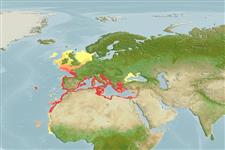Common names from other countries
>
Eupercaria/misc (Various families in series Eupercaria) >
Sparidae (Porgies)
Etymology: Pagellus: Diminutive of Latin, pager, derived from Greek, pagros = a fish, Dentex sp. (Ref. 45335).
More on author: Linnaeus.
Environment: milieu / climate zone / depth range / distribution range
Ecologia
marinhas bentopelágico; intervalo de profundidade ? - 300 m (Ref. 4781), usually 20 - 100 m (Ref. 4781). Subtropical; 63°N - 10°N, 32°W - 42°E
Eastern Atlantic: Norway and the Mediterranean to Guinea-Bissau (Ref. 26999), including Cape Verde, Madeira and the Canary Islands. Rarely recorded in Scandinavia (Ref. 4781).
Comprimento de primeira maturação / Tamanho / Peso / Idade
Maturity: Lm 14.2, range 13 - 16 cm
Max length : 60.0 cm SL macho/indeterminado; (Ref. 4781); common length : 25.0 cm SL macho/indeterminado; (Ref. 4781); peso máx. publicado: 3.2 kg (Ref. 40637)
Espinhos dorsais (total): 12; Raios dorsais (total): 10-11; Espinhos anais 3; Raios anais : 8 - 9. Body red without stripes or bars. Snout at least twice as long as the eye diameter (Ref. 35388).
Found on inshore waters, on various bottom (rock, gravel, sand and mud) to 200 m (Mediterranean) or 300 m (Atlantic) and move to deeper waters during winter. Omnivorous, but feed mainly on benthic invertebrates and small fishes (Ref. 3688). Protogynic hermaphrodites, females become males first in their third year with sizes of about 17 cm. Important food fish.
Possibly two spawning periods in the southern Mediterranean (Ref. 4781). Length at which sex change possibly occurs is between 12.8 and 20.3 cm FL (Ref. 57849).
Bauchot, M.-L. and J.-C. Hureau, 1990. Sparidae. p. 790-812. In J.C. Quero, J.C. Hureau, C. Karrer, A. Post and L. Saldanha (eds.) Check-list of the fishes of the eastern tropical Atlantic (CLOFETA). JNICT, Lisbon; SEI, Paris; and UNESCO, Paris. Vol. 2. (Ref. 3688)
Status na Lista Vermelha da UICN (Ref. 130435)
CITES (Ref. 128078)
Not Evaluated
Ameaça para os humanos
Reports of ciguatera poisoning (Ref. 4690)
Uso pelos humanos
Can't connect to MySQL database (fbapp). Errorcode: Too many connections
